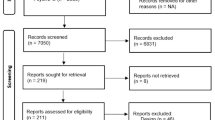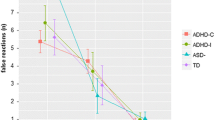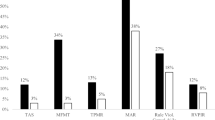Abstract
Attention and executive function (EF) dysregulation are common in a number of disorders including autism and attention-deficit/hyperactivity disorder (ADHD). Better understanding of the relationship between indirect and direct measures of attention and EF and common neurodevelopmental diagnoses may contribute to more efficient and effective diagnostic assessment in childhood. We obtained cognitive (NIH Toolbox, Little Man Task, Matrix Reasoning Task, and Rey Delayed Recall) and symptom (CBCL, and BPMT) assessment data from the Adolescent Brain and Cognitive Development (ABCD) database for three groups, autistic (N = 110), ADHD (N = 878), and control without autism or ADHD diagnoses (N = 9130) and used ridge regression to determine which attention and EF assessments were most strongly associated with autism or ADHD. More variance was accounted for in the model for the ADHD group (31%) compared to the autism group (2.7%). Finally, we ran odds ratios (using clinical cutoffs where available and 2 standard deviations below the mean when not) for each assessment measure, which generally demonstrated a greater significance within the indirect measures when compared to the direct measures. These results add to the growing literature of symptom variably across diagnostic groups allowing for better understanding of presentations in autism and ADHD and how best to assess diagnosis. It also highlights the increased difficulty in differentiating autism and controls when compared to ADHD and controls and the importance of indirect measures of attention and EF in this differentiation.
Similar content being viewed by others
Abbreviations
- ADHD:
-
Attention-Deficit Hyperactivity Disorder
- ABCD:
-
Adolescent Brain and Cognitive Development
- EF:
-
Executive Function
- CBCL:
-
Childhood Behavioral Checklist
- BPMT:
-
Brief Problem Monitoring Teacher Report
- KSAD:
-
Kiddie Score for Affective Disorders and Schizophrenia
- RAVLT:
-
Rey Auditory Verbal Learning Test
References
Achenbach, T.M., and L.A. Rescorla. 2001. (2001). Manual for the ASEBA School-Age Forms & Profiles.University of Vermont, Research Center for Children, Youth, & Families. Burlington
Bonnelle, V., et al. (2011). Default mode network connectivity predicts sustained attention deficits after traumatic brain injury. Journal of Neuroscience, 31(38), 13442–13451.
Bowler, D. M., Limoges, E., & Mottron, L. (2009). Different verbal learning strategies in Autism spectrum disorder: Evidence from the rey auditory verbal learning test. Journal of Autism and Developmental Disorders, 39(6), 910–915.
Boxhoorn, S., et al. (2018). Attention profiles in autism spectrum disorder and subtypes of attention-deficit/hyperactivity disorder. European Child and Adolescent Psychiatry, 27(11), 1433–1447. https://doi.org/10.1007/s00787-018-1138-8
Clark, B., & Bélanger, S. A. (2018). ADHD in children and youth: Part 3-assessment and treatment with comorbid ASD, ID, or prematurity. Paediatrics and Child Health (Canada), 23(7), 485–490.
Dellapiazza, F., et al. (2021). Clinical characteristics of children with ASD and comorbid ADHD: Association with social impairment and externalizing and internalizing behaviours. Research in Developmental Disabilities, 113(103930), 2023. https://doi.org/10.1016/j.ridd.2021.103930
Dickson, K. S., Suhrheinrich, J., Rieth, S. R., & Stahmer, A. C. (2018). Parent and teacher concordance of child outcomes for youth with Autism spectrum disorder. Journal of Autism and Developmental Disorders, 48(5), 1423.
Dugbartey, A. T., et al. (1999). WAIS-III matrix reasoning test performance in a mixed clinical sample. Clinical Neuropsychologist, 13(4), 396–404.
Earle, William James. 2014. “DSM-5.” Philosophical Forum.
Farhat, L. C., et al. (2022). ADHD and Autism symptoms in youth: A network analysis. Journal of Child Psychology and Psychiatry and Allied Disciplines, 63(2), 143–151.
Feil, E. G., et al. (2016). Early intervention for preschoolers at risk for attention-deficit/hyperactivity disorder: Preschool first step to success. Behavioral Disorders, 41(2), 95–106.
Gómez-Pérez, M., Mar, M. D., Calero, S. M., & Molinero, C. (2016). Discrepancies between direct and Indirect measures of interpersonal and neurocognitive skills in Autism spectrum disorder children. Journal of Clinical and Experimental Neuropsychology, 38(8), 875–886. https://doi.org/10.1080/13803395.2016.1170106
Harpin, V., et al. (2016). Long-term outcomes of ADHD: A systematic review of self-esteem and social function. Journal of Attention Disorders, 20(4), 295–305.
Hollingdale, J., et al. (2020). Autistic spectrum disorder symptoms in children and adolescents with attention-deficit/hyperactivity disorder: A meta-analytical review. Psychological Medicine, 50(13), 2240–2253.
Karcher, N. R., & Barch, D. M. (2021). The ABCD study: Understanding the Development of risk for mental and physical health outcomes. Neuropsychopharmacology, 46(1), 131–142. https://doi.org/10.1038/s41386-020-0736-6
Koch, J., & Exner, C. (2015). Selective attention deficits in obsessive-compulsive disorder: The role of metacognitive processes. Psychiatry Research, 224(3), 550–555.
Krakowski, A. D., et al. (2020). Inattention and hyperactive/impulsive component scores do not differentiate between Autism spectrum disorder and attention-deficit/hyperactivity disorder in a clinical sample. Mol Autism, 11(1), 1–13.
Kushki, A., et al. (2019). Examining overlap and homogeneity in ASD, ADHD, and OCD: A Data-driven, diagnosis-agnostic approach. Translational Psychiatry. https://doi.org/10.1038/s41398-019-0631-2
Lang, R., et al. (2010). Influence of Assessment setting on the results of functional analyses of problem behavior. Journal of Applied Behavior Analysis, 43(3), 565–567.
Luciana, M., et al. (2018). Adolescent neurocognitive development and impacts of substance use: Overview of the adolescent brain cognitive development (ABCD) baseline neurocognition battery. Developmental Cognitive Neuroscience, 32, 67–79. https://doi.org/10.1016/j.dcn.2018.02.006
Mick, E., Biederman, J., Pandina, G., & Faraone, S. V. (2003). A Preliminary Meta-Analysis of the Child Behavior Checklist in Pediatric Bipolar Disorder. Biological Psychiatry (pp. 1021–1027). Elsevier Inc.
Petty, C. R., et al. (2008). The child behavior checklist broad-band scales predict subsequent psychopathology: A 5-year follow-up. Journal of Anxiety Disorders, 22(3), 532–539.
Piper, B. J., Gray, H. M., Raber, J., & Birkett, M. A. (2014). Reliability and validity of brief problem monitor, an abbreviated form of the child behavior checklist. Psychiatry and Clinical Neurosciences, 68(10), 759–767.
Pollak, Y., Kahana-Vax, G., & Hoofien, D. (2008). Retrieval processes in adults with ADHD: A RAVLT study. Developmental Neuropsychology, 33(1), 62–73.
Rey, A. 1964. “Rey Auditory Verbal Learning Test (AVLT).” The Clinical Examination in Psychology.
Rey, J. M., Schrader, E., & Morris-Yates, A. (1992). Parent-child agreement on children’s behaviours reported by the child behaviour checklist (CBCL). Journal of Adolescence, 15(3), 219–230.
Shaw, M., et al. (2012). A systematic review and analysis of long-term outcomes in attention deficit hyperactivity disorder: effects of treatment and non-treatment. BMC Medicine. https://doi.org/10.1186/1741-7015-10-99
Toplak, M. E., West, R. F., & Stanovich, K. E. (2013). Practitioner review: Do performance-based measures and ratings of executive function assess the same construct? Journal of Child Psychology and Psychiatry, 54(2), 131–143.
Tureck, K., et al. (2013). Investigation of the rates of comorbid symptoms in children with ADHD compared to children with ASD. Journal of Developmental and Physical Disabilities, 25(4), 405–417.
Vakil, E., Blachstein, H., Wertman-Elad, R., & Greenstein, Y. (2012). Verbal learning and memory as measured by the rey-auditory verbal learning test: ADHD with and without learning disabilities. Child Neuropsychology, 18(5), 449–466.
van Steensel, F. J. A., Bögels, S. M., & de Bruin, E. I. (2013). Psychiatric comorbidity in children with Autism spectrum disorders: A comparison with children with ADHD. Journal of Child and Family Studies, 22(3), 368–376.
Weintraub, S., et al. (2013). Cognition assessment using the NIH toolbox. American Academy of Neurology, 80(11 Suppl 3), S54–S64.
Williams, R. G., Klamen, D. A., & McGaghie, W. C. (2003). Cognitive, social and environmental sources of bias in clinical performance ratings. Teaching and Learning in Medicine, 15(4), 270–292.
Funding
This study was supported by the Alberta Children’s Hospital Foundation and the Owerko Centre at the Alberta Children’s Hospital Research Institute.
Author information
Authors and Affiliations
Contributions
KH: Conceptualization, Methodology, Formal Analysis, Data Curation, Writing – Original Draft, Writing – Review & Editing, Visualization SB: Conceptualization, Methodology, Writing – Review & Editing, Supervision CMD: Writing – Review & Editing DD: Writing – Review & Editing KM: Conceptualization, Methodology, Resources, Writing – Review & Editing, Supervision.
Corresponding author
Ethics declarations
Conflict of interest
The authors have no example conflicts of interest to disclose.
Additional information
Publisher's Note
Springer Nature remains neutral with regard to jurisdictional claims in published maps and institutional affiliations.
Rights and permissions
Springer Nature or its licensor (e.g. a society or other partner) holds exclusive rights to this article under a publishing agreement with the author(s) or other rightsholder(s); author self-archiving of the accepted manuscript version of this article is solely governed by the terms of such publishing agreement and applicable law.
About this article
Cite this article
Harkness, K., Bray, S., Durber, C.M. et al. Assessing the Contribution of Measures of Attention and Executive Function to Diagnosis of ADHD or Autism. J Autism Dev Disord (2024). https://doi.org/10.1007/s10803-024-06275-9
Accepted:
Published:
DOI: https://doi.org/10.1007/s10803-024-06275-9




